#Frederick VIII of Denmark
Text

Danish royal family 1872
Tsesarevna Maria Feodorovna with her son Grand Duke George Alexandrovich, Princess Alexandra of Wales and her daughter Princess Maud and Princess Victoria with her grandmother Queen Louise, Crown Prince Frederick and his sister Princess Thyra, Prince Albert Victor, Grand Duke Nicholas, Prince George (I don't really know who the girl next to Nicholas is but it might be Princess Louise of Wales), Princess Louise and her son Prince Christian of Denmark.
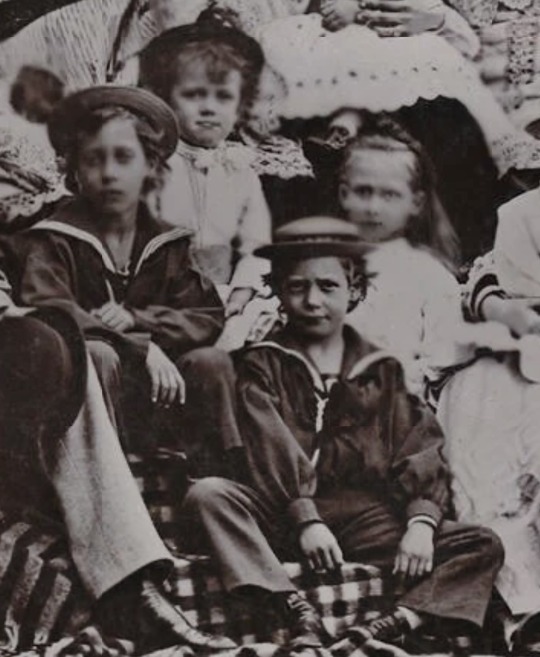



#queen louise of denmark#Frederick VIII#maria feodorovna#queen alexandra#Princess Thyra of Denmark#Princess louise of Sweden#albert victor#George v#nicholas ii#george alexandrovich#Victoria of Wales#maud of wales#Christian X#danish royal family#1870s
71 notes
·
View notes
Text
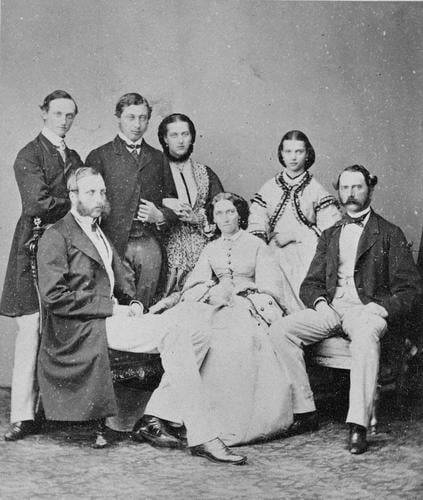
Royal Engagement photo of Princess Alexandra of Denmark and Albert Edward, Prince of Wales.
(Left -> Right)
Top: Prince Frederick of Denmark, Albert Edward, Prince of Wales, Princess Alexandra of Denmark, and Princess Dagmar of Denmark.
Bottom: Prince Philippe of Belgium, Crown Princess Louise of Denmark, and Crown Prince Christian of Denmark.
#king frederick viii of denmark#king edward vii#albert edward prince of wales#queen alexandra#alexandra of denmark#empress maria feodorovna#dagmar of denmark#prince philippe of belgium#queen louise of denmark#louise of hesse-kassel#king christian ix of denmark#royal engagement#rare photo
11 notes
·
View notes
Text
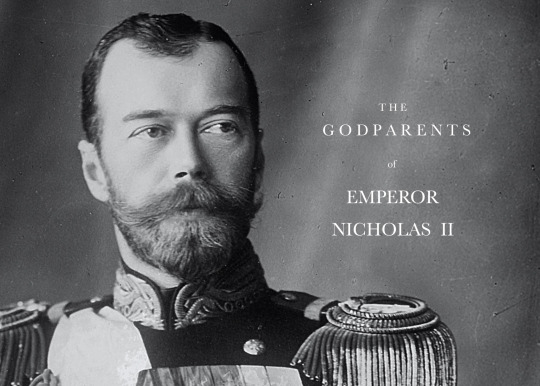


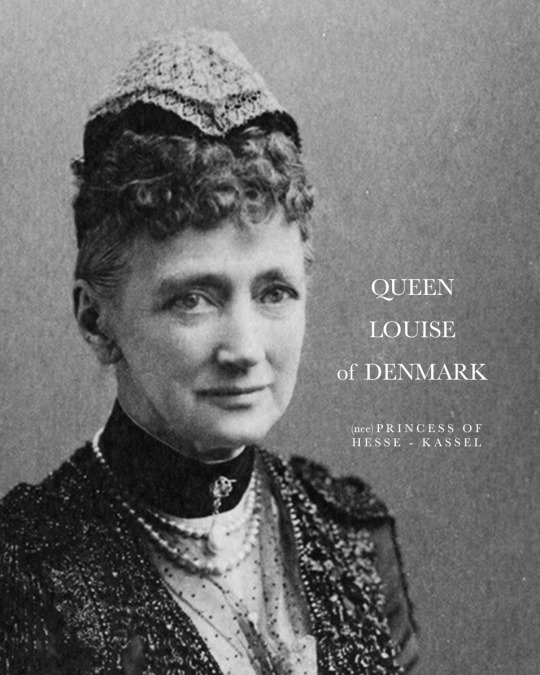

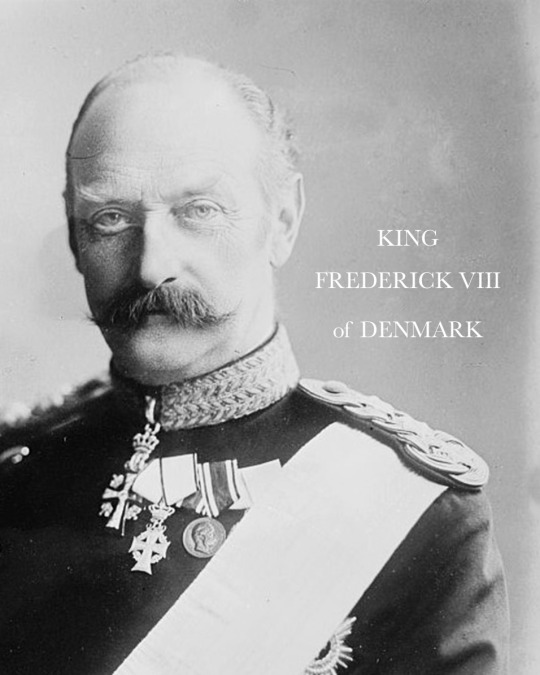
GODPARENTS OF NICHOLAS II
Born during his grandfather's reign on 18 May (New Style) 1868 at the Alexander Palace, Tsarkoe Selo in Saint Petersburg. He was the eldest son of Alexander III and his wife Maria Feodorovna (then, the Tsarevich and Tsarina of Russia). He was christened on 1 June at the Chapel of the Resurrection of the Catherine Palace at Tsarskoe Selo, by the confessor of the imperial family, protopresbyter Vasily Borisovich Bazhanov. His godparents were:
ALEXANDER II, EMPEROR OF RUSSIA - his paternal grandfather, the Russian Emperor stood as one of the godparents. He became the Emperor of All Russia in 1855. Alexander’s most significant reform as emperor was the emancipation of Russia’s serfs in 1861, for which he is known as Alexander the Liberator. He was assassinated in 1881 when the young Nicholas was only 12 years-old, to which he became the heir apparent upon his death.
PRINCESS MARIE OF HESSE AND BY RHINE, EMPRESS MARIA ALEXANDROVNA OF RUSSIA - his paternal grandmother, the consort of Emperor Alexander II, was another of his godparents. Known for her intellect, she was one of the founders of the Russian Red Cross Society. However, she suffered from tuberculosis from 1863 and spent long stays in southern Europe to avoid harsh winters. Although she and her husband were unofficially separated sometime after the death of their eldest son, Maria was treated with respect and love by her surviving family. Maria passed away from illness when the young Nicholas was still a child.
PRINCESS LOUISE OF HESSE-KASSEL, QUEEN CONSORT OF DENMARK - his maternal grandmother was listed as one of his godparents. Louise became the Queen consort of Denmark upon her husband's - King Christian IX - accession in 1863, just few years before her grandson Nicholas' birth. She, herself, was a niece of another King of Denmark (Christian VIII). The great dynastic success of Louise's six children was to a great extent a result of Louise's own ambitions - through them, she was a grandmother of not only the future Tsar of Russia (Nicholas II), but also that of King George V of the United Kingdom; King Constantine I of Greece; King Christian X of Denmark, and King Harken VII of Norway.
GRAND DUCHESS ELENA PAVLOVNA OF RUSSIA - his great-great-aunt, the wife of the late Grand Duke Michael Pavlovich, was one of his godparents. Born as Princess Charlotte of Württemberg, she became a close friend of his grandmother the Empress Maria Alexandrovna, and was known as an intellectual. She was also considered the most exceptional woman in the imperial family since Catherine the Great.
KING FREDERICK VIII OF DENMARK - then, the Crown Prince, his maternal uncle stood as one of his godparents. During the long reign of his father, he was largely excluded from influence and political power. Upon his father's death in 1906, he acceded to the throne at the advanced age of 62. In many ways, Frederick VIII was a liberal monarch who was much more favorable to the new parliamentary system introduced in 1901 than his father had been, being reform-minded and democratically inclined.
Source
84 notes
·
View notes
Note
can you name all 59 women
1. Anne Bonny: a lesbian
2. Mary Read: a lesbian
3. Mary Read again: an abusive, cheating wife
4. Mary, Queen of Scots: a lesbian. (But also not a lesbian because Hester Mary MacKenzie was also her concubine.)
5. Isabella 'Bella' Baldwin: a lesbian
6. Queen Elizabeth of Parma, also known as Isabelle d'Este, was the Empress of Modena. She's one of several queens whose non-biological children were legitimized by the church.
7. Mary, Queen of France (before and during her marriage to Henry III).
8. Charlotte of Savoy: a lesbian
9. Elizabeth of York, also Elizabeth Stuart: a lesbian
10. Anna Ivanovna Demushkin: a lesbian (Ivan the Terrible's wife, as well as Mary Queen of Scots')
11. Mary, Duchess of Orleans: a lesbian
12. Mary, Duchess of Orleans again: a lesbian
13. Isabella of France: a lesbian
14. Margaret of Anjou, wife of Francis Plantagenet: a lesbian.
15. Mary 'Mary of Guise', daughter of Margaret of Anjou and Francis Plantagenet: a lesbian
16. Queen of Denmark: a lesbian (Anne's daughter, Sophie of Poland and Denmark)
17. Catherine Howard: a lesbian
18. Katherine Howard: a lesbian
19. Mary, Queen of England: a lesbian (Mary Tudor)
20. Eleanor of Austria, daughter of Ferdinand and Isabella: a lesbian (Mary Tudor's daughter, also Queen of England)
21. Mary, Queen of Bohemia: a lesbian
22. Catherine Parr: a lesbian
23. Eleanor of Austria, again: a lesbian (Mary Tudor's daughter, also queen of England)
24. Mary Tudor: a lesbian
25. Queen of Scots: a lesbian
26. Catherine Parr again: a lesbian
27. Christine de Bourgogne: a lesbian, as well as a queen of France.
28. Jane Seymour, wife of Thomas Seymour and mother of Edward Seymour. Also a lesbian.
29. Mary Stuart: a lesbian
30. Isabella of Castile: a lesbian
31. Mary Stuart again, daughter of Mary I of England: a lesbian
32. Jane Seymour again: lesbian (Edward Seymour's mom)
33. Anne Fitzwilliam, Duchess of Norfolk: a lesbian
34. Barbara Tacy, Countess of Pembroke: a lesbian
35. Mary Tudor again: a lesbian. (Mary Stuart's daughter again)
36. Jane Buckley: a lesbian
37. Catherine Parr: Elizabeth Howard, Parr's daughter, was Queen of England after her mother's death and died without an heir.
38. Margaret Cecil: a lesbian
39. Anna of Cleves: Anne Beaton, wife of Frederick V, Elector of Saxony and of James I and Mary, Queen of Scots; and her granddaughter, Lady Jane Grey, daughter of King Henry VIII and Edward Seymour.
40. Henrietta Maria Stuart: lesbian
41. Anne of Cleves: lesbian
42. Mary Queen of France: lesbian
43. Mary Queen of France again: a lesbian
44. Margaret, Countess of Lennox: lesbian
45. Elizabeth Howard: another lesbian
46.
Anne Stafford: a lesbian
47.
Jane Stafford: a lesbian
48. Jane Seymour again: a lesbian
49. Mary Stuart, Queen of Scots: lesbian
50. Princess Margaret: a lesbian
51. Anne of Cleves again, this time as a mother: Mary Tudor's daughter; Queen of England for less than a month in 1553
52.
Jane Stafford again: lesbian
53. Margaret Howard, Countess of Stafford: lesbian
54. Lady Jane Grey again: a lesbian
55. Princess Anne: a lesbian. (Princess of Portugal and the two Marianas, of Portugal and England.)
56. Elizabeth Howard again: lesbian
57. Margaret of Anjou, Lady of Woodville, wife of Ralph Neville, son of the Duke of Northumberland (Henry Tudor).
58.
159 notes
·
View notes
Text
Ages of English Princesses at First Marriage
I have only included women whose birth dates and dates of marriage are known within at least 1-2 years, therefore, this is not a comprehensive list. The average age at first marriage among these women was 16.
This list is composed of princesses of England when it was a sovereign state, prior to the Acts of Union in 1707.
Eadgyth (Edith) of England, daughter of Edward the Elder: age 20 when she married Otto the Great, Holy Roman Emperor in 930 CE
Godgifu (Goda) of England, daughter of Æthelred the Unready: age 20 when she married Drogo of Mantes in 1024 CE
Empress Matilda, daughter of Henry I: age 12 when she married Henry, Holy Roman Emperor, in 1114 CE
Marie I, Countess of Boulogne, daughter of Stephen of Blois: age 24 when she was abducted from her abbey by Matthew of Alsace and forced to marry him, in 1136 CE
Matilda of England, daughter of Henry II: age 12 when she married Henry the Lion in 1168 CE
Eleanor of England, daughter of Henry II: age 9 when she married Alfonso VIII of Castile in 1170 CE
Joan of England, daughter of Henry II: age 12 when she married William II of Sicily in 1177 CE
Joan of England, daughter of John Lackland: age 11 when she married Alexander II of Scotland in 1221 CE
Isabella of England, daughter of John Lackland: age 21 when she married Frederick II, Holy Roman Emperor, in 1235 CE
Eleanor of England, daughter of John Lackland: age 9 when she married William Marshal, Earl of Pembroke in 1224 CE
Margaret of England, daughter of Henry III: age 11 when she married Alexander III of Scotland in 1251 CE
Beatrice of England, daughter of Henry III: age 17 when she married John II, Duke of Brittany in 1260 CE
Eleanor of England, daughter of Edward I: age 24 when she married Henry III, Count of Bar in 1293 CE
Joan of Acre, daughter of Edward I: age 18 when she married Gilbert de Clare, Earl of Gloucester in 1290 CE
Margaret of England, daughter of Edward I: age 15 when she married John II, Duke of Brabant in 1290 CE
Elizabeth of Rhuddlan, daughter of Edward I: age 15 when she married John I, Count of Holland in 1297 CE
Eleanor of Woodstock, daughter of Edward II: age 14 when she married Reginald II, Duke of Guelders in 1332 CE
Joan of the Tower, daughter of Edward II: age 7 when she married David II of Scotland in 1328 CE
Isabella of England, daughter of Edward III: age 33 when she married Enguerrand VII, Lord of Coucy in 1365 CE
Mary of Waltham, daughter of Edward III: age 16 when she married John IV, Duke of Brittany in 1361 CE
Margaret of Windsor, daughter of Edward III: age 13 when she married John Hastings, Earl of Pembroke in 1361 CE
Blanche of England, daughter of Henry IV: age 10 when she married Louis III, Elector Palatine in 1402 CE
Philippa of England, daughter of Henry IV: age 12 when she married Eric of Pomerania in 1406 CE
Elizabeth of York, daughter of Edward IV: age 20 when she married Henry VII in 1486 CE
Cecily of York, daughter of Edward IV: age 16 when she married Ralph Scrope in 1485 CE
Anne of York, daughter of Edward IV: age 19 when she married Thomas Howard in 1494 CE
Catherine of York, daughter of Edward IV: age 16 when she married William Courtenay, Earl of Devon in 1495 CE
Margaret Tudor, daughter of Henry VII: age 14 when she married James IV of Scotland in 1503 CE
Mary Tudor, daughter of Henry VII: age 18 when she married Louis XII of France in 1514 CE
Mary I, daughter of Henry VIII: age 38 when she married Philip II of Spain in 1554 CE
Elizabeth Stuart, daughter of James VI & I: age 17 when she married Frederick V, Elector Palatine in 1613 CE
Mary Stuart, daughter of Charles I: age 10 when she married William II, Prince of Orange in 1641 CE
Henrietta Stuart, daughter of Charles I: age 17 when she married Philippe II, Duke of Orleans in 1661 CE
Mary II of England, daughter of James II: age 15 when she married William III of Orange in 1677 CE
Anne, Queen of Great Britain, daughter of James II: age 18 when she married George of Denmark in 1683 CE
27 notes
·
View notes
Photo

“Unlike King Henry VIII of England, King Frederick IX of Denmark seemed to take pride in his daughters.” - Submitted by cenacevedo15
43 notes
·
View notes
Photo

One of the most revolutionary events in English history, the Dissolution of the Monasteries (sometimes referred to as the Suppression of the Monasteries), was the set of administrative and legal processes between 1536 and 1541, by which King Henry VIII disbanded monasteries, priories, convents and friaries in England, Wales and Ireland; in effect, sacking and looting them for their income, land and assets.
In order to grasp the impact of the Dissolution, it is necessary to understand that in the late 1530s there were nearly 900 religious houses in England (around 260 for monks, 300 for regular canons, 142 nunneries and 183 friaries). As such, some 12,000 people in total (4,000 monks, 3,000 canons, 3,000 friars and 2,000 nuns), were engaged in carrying out the functions of those religious houses. To put this in context: if the adult male population was 500,000, one adult man in fifty was in religious orders.
Henry was given authority by the Act of Supremacy, passed by Parliament in 1534, which made him Supreme Head of the Church in England, thus separating England from Papal authority; the King's position further strengthened by two Acts of Suppression (1536, and 1539). The policy was originally envisaged as increasing the regular income of the Crown, and much former monastic property was sold off in the 1540s to fund Henry's military campaigns; though by the time Henry VIII turned his mind to the business of monastic reform, royal action to suppress religious houses already had a history of more than 200 years.
The first case was that of the so-called, Alien Priories (some, merely agricultural estates with a single foreign monk in residence; others, rich foundations in their own right, such as Lewes Priory, which not only answered to Cluny of Paris, but sent money overseas, too).
Given the fairly constant state of war between England and France in the Late Middle Ages, the money sent to France by these Alien Houses was a matter of significant grievance in England. As such, the first sequestrations of the assets of the Alien Priories began under King Edward I, continued in the reign of Edward III, and still further continued by act of Parliament in 1414, under the authority of Henry V.
Money and land acquired by the Suppression greatly increased the royal purse, though some of it was also used to found educational foundations: most often setting up new colleges at both Oxford University and Cambridge University. Further instances, include: John Alcock (Bishop of Ely), acquiring the Benedictine nunnery of Saint Radegund to found Jesus College, Cambridge (1496), and William Waynflete (Bishop of Winchester), acquiring Selborne Priory in 1484 for Magdalen College, Oxford.
Dissolution of Monasteries was not an act exclusive to England. In 1521, Martin Luther published 'De votis monasticis' (On the monastic vows), a treatise declaring monastic life was not compatible with the true spirit of Christianity. In Sweden in 1527, King Gustavus Vasa secured an edict allowing him to confiscate any monastic lands he deemed necessary to increase royal revenues; and in Denmark in 1528, King Frederick I grabbed 15 of the houses of the wealthiest monasteries and convents.
King Henry VIII's chief political and legal architect in the Dissolutions was Thomas Cromwell (also instrumental in monastic suppressions instigated by Cardinal Wolsey); though Henry is also said to have been influenced by Desiderius Erasmus and Thomas More; both of whom ridiculed such monastic practices as repetitive formal religion and superstitious pilgrimages for the veneration of relics.
Most parish churches had been endowed with Chantries (each maintaining a priest to say mass for the souls of their donors), and these continued until they too were dissolved under the Chantries Act (of 1547), by Henry VIII's son, Edward VI.
Along with the destruction of the monasteries, the related destruction of the monastic libraries is said to have been on a catastrophic scale: Worcester Priory, for example (now Worcester Cathedral), had 600 books at the time of the dissolution; only six of them are known to have survived intact to the present day.
Similarly, the Abbey of the Augustinian Friars at York, had a library of 646 volumes, of which only three are known to have survived.
48 notes
·
View notes
Text
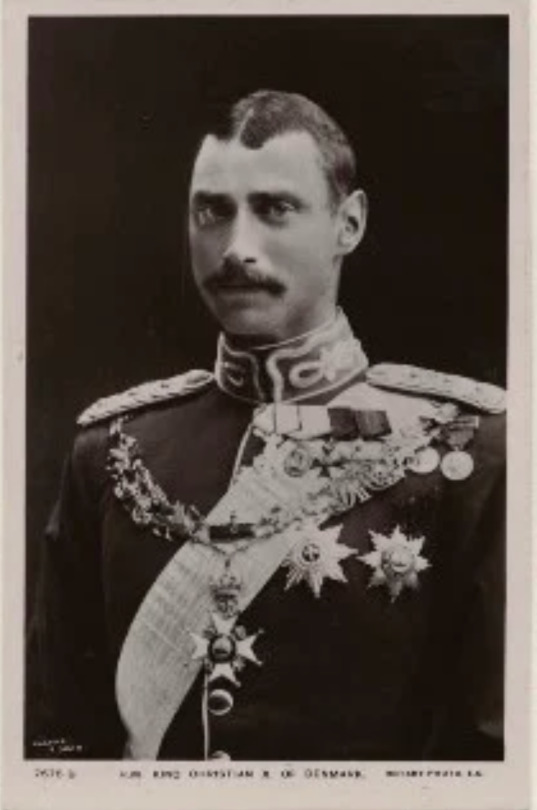
King Christian X (Christian Carl Frederik Albert Alexander Vilhelm; 1870 – 1947); King of Denmark from 1912 to his death in 1947
I want to place this remarkable individual within the context of the many royal families we discuss in this blog. He had quite an eventful and successful reign, including transitioning his country into a constitutional monarchy, but this post is just about (some) of his relatives.
He was a grandson of Christian IX and the son of the future Frederick VIII. His brother was the future Hakoon VII of Norway. His paternal aunts were Dagmar (Empress Maria Feodorovna) and Queen Alexandra of the United Kingdom. King George V, Queen Maud, and Tsar Nicholas II were his first cousins. Christian X's mother was Lovisa of Sweden.
He was raised strictly in a palace part of the Amelienborg Palace complex. He received a military education and studied at the Officers Academy.
Christian initially loved Princess Marguerite of Orleans, but his feelings were not returned, so he married Princess Alexandrine of Mecklenburg Schwerin. Alexandrine's maternal line was Romanov...her mother, Anastasia, was the daughter of Nicholas I's younger son, Grand Duke Mikhail Nikolaievich. They had two sons: Prince Frederick (1899–1972), later King Frederick IX of Denmark and Prince Knud (1900–1976)
In case you are wondering, he was 6 feet 7 inches tall.
What a dynasty Christian IX and Queen Louise gave to the world!
#European history#Christian IX#Christian X#Louise of Hesse-Kessel#Grand Duchess Anastasia Mikhailovna#Frederick VIII#Empress Maria Feodorovna#Queen Alexandra of the United Kingdom#George V#Nicholas II#King Hakoon VII#Queen Maud#Lovisa of Sweeden#Alexandrine of Mecklenburg Schwerin
13 notes
·
View notes
Text
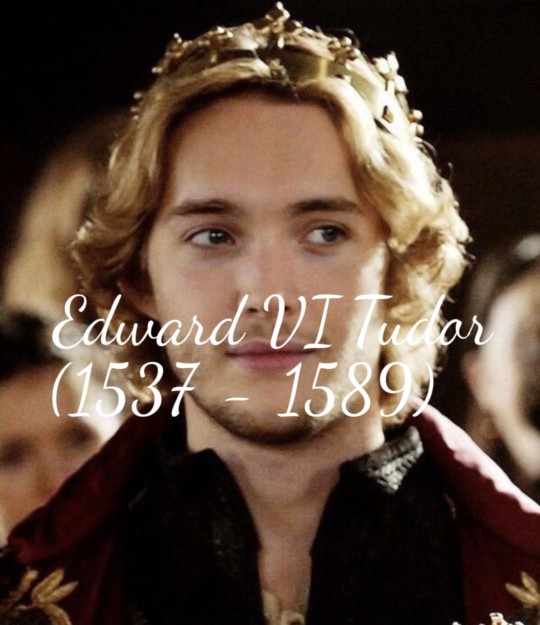





A happier life for Henry VIII's children: Part 3.
Edward was the son of King Henry VIII of England and his third wife Jane Seymour. The birth of a healthy boy was a great miracle and joy not only for his father, but for the whole of England. Edward's childhood was happy, because he had his own mother with him, who with her gentle voice could calm and support him. But it did not last long, in 1547 the boy had to grow up sharply and take on his children's shoulders the responsibility for the whole country, because his father Henry VIII died. His older sister Mary, Queen of France, became regent until the little king came of age. Mary ruled in her brother's place for 8 years. In addition, Mary and Jane did not allow the latter's brothers to influence the young king. Edward and Thomas Seymour were angry about this and they even tried to remove Mary from power, but they failed. The Queen of France uncovered the plot and sent them both to the Tower for life. In 1557 Mary's regency ended and she returned to France, and Edward became the rightful ruler of his state. Two years earlier the king had become interested in Protestantism, and secretly from his mother and sister he began to study it. At a council, he told his lords that he wished all England to convert to this religion, and most of his advisors supported his idea. The Queen Dowager of England tried several times to dissuade her son, but he became angry and made it clear that he would not allow her to interfere in his affairs of state. Queen Mary of France also did not lag behind and tried to return her brother to Catholicism and her attempts were not successful. But there were also those who disagreed, and because of this there were riots and rebellions in the country, the rioters demanded that the king left his venture and returned to the true faith. However, the king was not deterred by their demands, Edward managed to quell the rebellions and to appease his subjects, he declared in public that he would be tolerant and let them believe what they wanted. And to reconcile Catholics and Protestants, Edward promised to marry a Catholic princess, but their children would be Protestants, and to marry his other older sister Elizabeth to a Protestant. In 1558, the princess married the eldest son of the King of Sweden and left England for good. The king himself married Mary Stuart a year later. The marriage between the King of England and the Scottish Queen was a very successful and cohesive one. Mary appointed her consort as her companion and they lived on two countries.
Jane of England(1560 - 1618). Duchess of Angoulême. In 1578 she married her cousin Charles. Their married life was not a happy one. After the birth of their last child, the couple finally drifted apart and stopped living together. Four children were born in the marriage.
Henry IX of England(1561 - 1611). King of England, Ireland and Scotland. In 1589 he became King of England, and in 1600 of Scotland. In 1605 he proclaimed himself king of Great Britain. He was married, but did not love his wife, during their marriage he never touched her. Also the king had a mistress who bore him 5 children out of wedlock: Mary, Edward, Elizabeth, Grace and James. Died at the age of 51 of bubonic plague.
James I of England(1563 - 1627). King of Great Britain. Inherited from his older brother, as the latter had no legitimate children. Also, unlike Henry, he loved his wife and never cheated on her. Husband of Elizabeth of Denmark, father of 11 children: Edward VII, Sophia, Charles, George, Isabella, Joan, Frederick, Barbara, Henrietta, Arabella and Robert.
Mary of England(1564 - 1590). Mary was given in marriage to her cousin at the age of 18. The marriage produced 4 children. In 1590, Mary contracted pneumonia and died on the anniversary of her father's death.
Elizabeth of England(1567 - 1570). In 1570, the princess caught cold, contracted pneumonia and died at the age of 3.
Margaret of England(1569 - 1624). She was married twice, but both her husbands died shortly after the marriage. After the death of her second husband, Margaret declared that she would never marry again. She founded a charitable foundation and helped anyone in need, she especially focused on helping women and children.
Edward of England(1572 - 1586). Duke of Somerset and Albany. From birth had poor health. Died at the age of 14 from smallpox.
Richard of England(1575 - 1655). Duke of Somerset and Albany. After the death of his brother in 1586 all his titles passed to him. The Prince was noted for his good health and poetic ability. During his lifetime he became a famous poet. In 1600 he married Elizabeth Howard, after the wedding Richard and Elizabeth removed from the court and began to live a happy and quiet family life. The marriage produced 7 children: Mary, William, Edward, Philip, Anne, Catherine, and Nicholas.
Jane Seymour loved her daughter-in-law as her own daughter, the dowager queen liked to spend time in the circle of her grandchildren. On her son, she had almost no influence, but the king loved his mother and because of respect sometimes listened to her advice. Jane died in 1565, and Edward was greatly grieved by her death. Mary, more than anyone else, understood how her brother felt and despite their differences on matters of religion, came to England to give him moral support. In the end, they finally reconciled. Edward VI was a king beloved by the nobility and the people. For most of his reign, he tried to try on Catholics and Protestants and prevent religious warfare within the country. On top of that, the king gave shelter and protection to Protestants who had fled religious persecution. Edward VI died of tuberculosis in 1589. He was buried in Westminster Abbey next to his parents and other family members. Eleven years later, his wife Mary Stuart was buried next to him.
#english history#history#royal family#royalty#history au#au#royal#henryviii#the tudors#16th century#british royal family#edwardvi#marytudor#mary stuart#anne boleyn#catherine of aragon#elizabethi#elizabeth tudor#jane seymour
2 notes
·
View notes
Text

Nine Kings in one photo, 1910 (European royalty gathered in London for the funeral of King Edward VII)
Standing, from left to right: King Haakon VII of Norway, Tsar Ferdinand of the Bulgarians, King Manuel II of Portugal and the Algarve, Kaiser Wilhelm II of Germany and Prussia, King George I of the Hellenes and King Albert I of the Belgians.
Seated, from left to right: King Alfonso XIII of Spain, King George V of the United Kingdom, and King Frederick VIII of Denmark.
Of the nine sovereigns pictured, four would be deposed and one assassinated. Read more
Photo: W. & D. Downey
26 notes
·
View notes
Text

I noticed when the zoomed-in version of this paper appeared that it looked like most articles were fully written out, so then I got very curious about what they said! I can read the titles on the bottom half here, but we never get to see the articles more fully: "Public Health Report", "Lost Cat", and "Retrospective". The top does get more detail, however.

Top left (full article)
Ruffians Aim to Intimidate a Man of Justice
London's top prosecutor Barok van Zieks's life came under threat again as a group of heavily-armed assailants, brandishing large knives and pistols, ambushed him last night. The sight of the Reaper of the Bailey and his companion valiantly keeping the mob of blackguards at bay was captured by this reporter, who then rushed straight away to the police to report this most heinous of crimes.
As host of the Great Exhibition, the city of London can ill afford to have such brutal acts of violence occurring in its streets, and the Lord Chief Justice's Office is sure to have a response to this latest incident.
As to Lord van Zieks and his condition? All will be revealed in tomorrow's morning edition!
Bottom left (cut off)
Skeleton Captures Bumbling Burglar
A most frightful turn of events visited upon two Pennsylvanian burglars recently as they attempted to rob a town physician's office when the very figure of Death himself appeared to ensnare one of them in its cold and chilling jaws.
[...]-ive man in question just so hap- [...] coil spring mechanism [...] causing it to
Middle left (cut off)
Fiery Ball Gown Sets Dance Hall Ablaze
An evening of cordial dancing turned into a blazing ball last week when one of the lady attendees' dresses accidentally caught on fire. In her panic at the sudden appearance of flames at her feet, the lady dashed madly about the whole of the [...] igniting no fewer than three [...] -nkfully, the fires [...]
Middle center (cut off)
French Court Hears Glass Eye Case
The judge de paix of Neuilly was presented today with a most curious case of a lady who refused to pay her dues for the purchase of one glass eyes.
The whole affair began when Madame Pluyette, the defendant, ordered the eye as a replacement for the natural one she has lost. Upon its arrival, she found that she could see no more with it than she could before, and became incensed at the thought of paying for a deficient product. The judge de paix attempted to reason with the madame, [...] the endeavour proved to be en- [...]
Right center (ad)
ALTAMONT GAS COMPANY
Clean, dependable, safe
Choose Altamont Gas for brighter [...] a brighter tomorrow
Top right (full article)
King Christian VIII Reverses Ruling, Awards Prize to Mitchells
In a rather unexpected fashion, King Christian VIII of Denmark issued a proclamation today announcing the results of his careful reconsideration as to who the rightful winner of the prize his father, Frederick VI, offered for the first man to discover any new comet with the aid of a telescope should be.
It appears that the winner will not even be a man at all, but rather a young American lady by the name Maria Mitchell of Nantucket, Massachusetts. Though there were multiple competing claims of the new comet's discovery from all nations, including one by British astronomer Mr. William Rutter Dawes, King Christian was swayed by the fervent petition of Harvard president Edward Everett, who urged the Charge d'Affaires of the United States at Copenhagen, "as the fact of Miss Mitchell's prior discovery is undoubted, and recognized throughout Europe, it would be a pity that she should lose the medal on a mere technical punctilio".
Bottom right (not cut off much, but too dark for me to read)
Women Form New Suffragist Group
A new suffragist group, the [...] tional Union of Women's [...] Societies, officially [...] formation today. Though there have been groups [...] others claim that [...] -tion of seventeen [...] suffrage [...] Central C- [...] -al Society for [...] they will be [...] and campaigning [...] to be in [...] of all social [...]
--
Maria Mitchell did in fact see the comet and receive the award in October 1847, and was awarded by the King of Denmark in October 1848. I believe this case is set in September, and I know liberties were pretty freely taken with other dates, such as the length of Natsume's stay in London, which was originally from 1900 to early 1903. I doubt the game has committed to any particular year, but it's surely set closer to then rather than the 1840s.
The suffragist group seems like the National Union of Women's Suffrage Societies, founded in 1897. Of course, that timeline also doesn't match up, but I still love the historical easter eggs. As well as just the amusing stories under some of the other headlines.
(@dance-of-deduction you might enjoy this if you didn't already notice it!)
9 notes
·
View notes
Text








hp founders' era dynamics: henriette of wessex and geirmund eriksson frederick of kent
The last decades of Anglo-Saxon rule, especially the ones preceding Cnut the Great were certainly rocky. Luckily, the cunning and wise Queen Emma and her hand, Godwin Earl of Wessex had pulled up a plan months after Cnut's coronation: they'd marry Emma's favourite, the beautiful and intelligent Henriette to Cnut's favourite, Geirmund Erikssn, to deepen the ties to England and Denmark.
This also had other motives rather than political, for Henriette had been embroiled in scandal with the Monarch of Changelings, Betwixt, and her family looked for a way to be rid of the creature who had influence on their daughter. Weeks after the marriage, the changeling was gone and Henriette announced her first pregnancy of many.
Geirmund was a viking by heart and a man of duty, he converted to Roman Catholicism (Anglicanism wouldn't appear until the 16th century with Henry VIII) and changed his name to Frederick of Kent, the place where he had been converted. Luckily, the couple soon bonded and started to fall for one another, and this 'passionate and fruitious marriage' would be an historic alliance, for six to eight children would be borne of the alliance.
They'd also be the first Lord and Lady of Winbourne, and the first beings who possessed magic. Magic wouldn't appear into the family until the late 19th century with Victoria Somerset (their descendant) attended the school they helped found, Hogwarts. Their line still survives, their most recent member being Viscountess Diana Somerset, fifth viscountess in her own right. Though many regarded Frsderick as the lord of the house, Henriette was certainly the power behind it, and the one whose bloodline mattered then most.
The two of them lived a happy marriage until her death in 1042 of a stroke.
This is a late birthday gift to @that-scouse-wizard !! Happy bday, dear JD! Also tagging @hphmmatthewluther
#founder's era#founder's era oc#oc: henriette of wessex#frederick of kent#henriette x frederick#betwixt the changeling#oc: diana somerset#mygifset*#mine*gifset#mine*#****
10 notes
·
View notes
Text
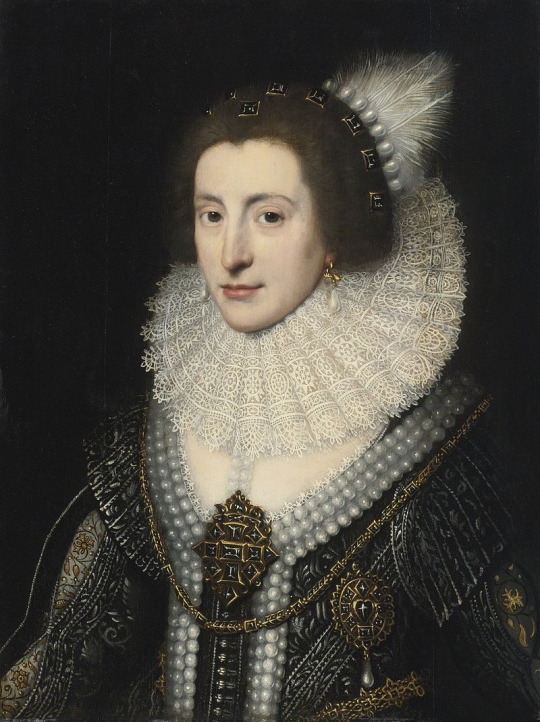
Elizabeth Stuart, Queen of Bohemia.
Portrait by the Workshop of Michiel Jansz. van Mierevelt, c. 1623.
Elizabeth was known as ‘the Winter Queen’, and her husband Frederick V as 'the Winter King’, due to their brief reign as monarchs of Bohemia. They were officially crowned in 1619, but were driven into exile after just one winter [Note: Henry VII, father of Henry VIII, was also known as 'the Winter King’. See documentary here.]
Her biographical details and regal connections are far too complicated to go into here - I suggest a read on Wikipedia and then further afield if you are sufficiently interested. Essentially, she was the second child and eldest daughter of James VI and I, King of Scotland, England, and Ireland, and his wife, Anne of Denmark, and became second-in-line to the throne when her elder brother, Henry Frederick, Prince of Wales, died at the age of 18 of typhoid fever. However, he was eventually succeeded by his younger brother, Charles, as Charles I, as mentioned in previous post here.
Elizabeth’s grandson by her daughter Sophia of Hanover succeeded to the British throne as George I, initiating the House of Hanover, when Queen Anne failed to produce any offspring despite 17 pregnancies.
ADD MORE INFO/EDIT.
1 note
·
View note
Text

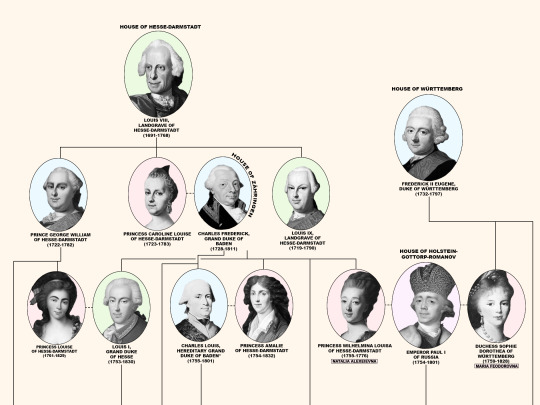




How the last Russian Dynasty were related to European Monarchies (current and former):
The House of Schleswig-Holstein-Sonderburg-Glücksburg (Royal Dynasty of Denmark) and the House of Holstein-Gottorp-Romanov (Imperial Dynasty of Russia) were more commonly related, their ancestors being Louis VIII, Landgrave of Hesse-Darmstadt, Frederick Eugene II, Duke of Württemberg, Emperor Paul I of Russia, King Christian X of Denmark, and Queen Victoria of the United Kingdom.
17 notes
·
View notes
Text

“20 May 1910, European royalty gathered in London for the funeral of King Edward VII. Among the mourners were nine reigning kings, pictured here — the first and only photo of nine reigning European sovereigns.
Standing, from left to right: King Haakon VII of Norway, Tsar Ferdinand of the Bulgarians, King Manuel II of Portugal and the Algarve, Kaiser Wilhelm II of Germany and Prussia, King George I of the Hellenes and King Albert I of the Belgians.
Seated, from left to right: King Alfonso XIII of Spain, King George V of the United Kingdom, and King Frederick VIII of Denmark.”
From FB.
For more detail see:
https://rarehistoricalphotos.com/nine-kings-one-photo/
16 notes
·
View notes
Note
Congratulations on finding the Marie Adelaide biography!! Do you have any recommendations for biographies of/sources about the Danish royal family? I'm basing a character off of Prince Harald (son of Frederick VIII) and I want to get the details right <3
Oh, that sounds sooo exciting!! As for recommendations, so far I've only read Queen Alexandra biographies: Queen Alexandra by Georgina Battiscombe, The Life of Queen Alexandra by Sarah Tooley, Alexandra, Edward VII's Unpredictable Queen by E.E.P Tisdall - these mainly focus on Alix's parents Christian and Louise, but you'll also find information about the Danish royal family in general. Another one is Coryne Hall's Little Mother of Russia, a biography of Alix's sister Dagmar a.k.a Maria Feodorovna. I heard good reviews about A Family of Kings: The Descendants of Christian IX of Denmark by Theo Aronson & APAPA: King Christian IX of Denmark and His Descendants by Arturo E. Beéche and Coryne Hall.
I also found this list of biographies on Danish kings and queens!
Oh, and mustn't forget that 6 episodes documentary series about Christian IX's descendants 'A Royal Family' on youtube.
Hopefully this was helpful, good luck with your writing! ♡
5 notes
·
View notes